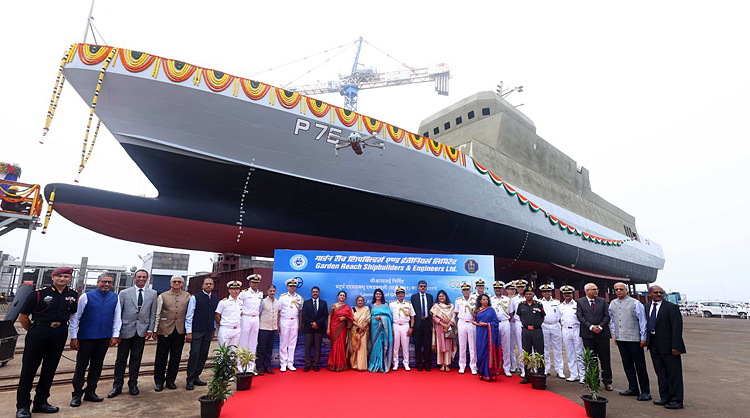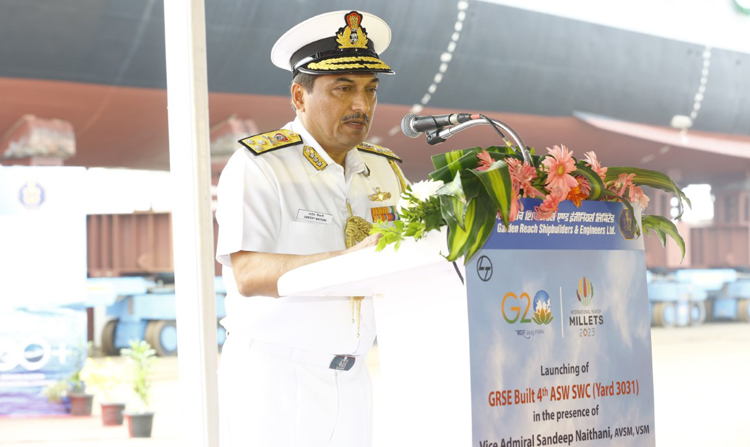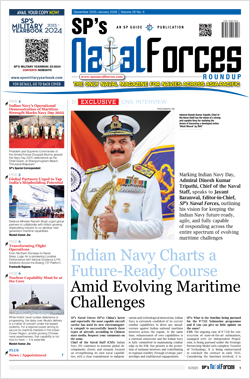INDIAN ARMED FORCES CHIEFS ON OUR RELENTLESS AND FOCUSED PUBLISHING EFFORTS

The insightful articles, inspiring narrations and analytical perspectives presented by the Editorial Team, establish an alluring connect with the reader. My compliments and best wishes to SP Guide Publications.

"Over the past 60 years, the growth of SP Guide Publications has mirrored the rising stature of Indian Navy. Its well-researched and informative magazines on Defence and Aerospace sector have served to shape an educated opinion of our military personnel, policy makers and the public alike. I wish SP's Publication team continued success, fair winds and following seas in all future endeavour!"

Since, its inception in 1964, SP Guide Publications has consistently demonstrated commitment to high-quality journalism in the aerospace and defence sectors, earning a well-deserved reputation as Asia's largest media house in this domain. I wish SP Guide Publications continued success in its pursuit of excellence.
- Global Partners Urged to Tap India's Shipbuilding Potential: Rajnath Singh at Samudra Utkarsh
- All about HAMMER Smart Precision Guided Weapon in India — “BEL-Safran Collaboration”
- India, Germany deepen defence ties as High Defence Committee charts ambitious plan
- G20 Summit: A Sign of Global Fracture
- True strategic autonomy will come only when our code is as indigenous as our hardware: Rajnath Singh
- India–Israel Joint Working Group Meeting on defence cooperation to boost technology sharing and co-development
Fourth ASW Warship Launched
India advances naval power as new anti-submarine craft is launched and INS Vikrant attains full operational status
 |
The Author is Former Director General of Information Systems and A Special Forces Veteran, Indian Army |

According to the media reports of November 17, 2023, 16 Anti-Submarine Warfare Shallow Water Crafts (ASW SWC) are presently being built indigenously in India – eight by the Public Sector Undertaking (PSU) Garden Reach Shipbuilders and Engineers (GRSE) at Kolkata and eight at another PSU. At Mumbai, the premier warship building yard Mazagon Docks Limited is currently engaged in construction of Kolkata Class and P15B destroyers plus stealth frigates of the Shivalik Class.
Defence PSU GRSE on November 16 launched INS 'Amini', the fourth of the eight Anti-Submarine Warfare Shallow Water Crafts (ASW SWC) it is building for the Indian Navy. The ASW SWCs are designed for: finding, tracking, and deterring enemy submarines; damaging or destroying enemy submarines; defending against intruding aircraft; mine laying, and; search-and-rescue (SAR). The ASW SWCs are equipped with advanced sonar and armed with latest weaponry such as lightweight torpedoes and ASW rockets.
GRSE launched INS 'Amini', the fourth of the eight Anti-Submarine Warfare Shallow Water Crafts (ASW SWC) it is building for the Indian Navy
The name 'Amini' is derived from an oval-shaped island in the Lakshadweep archipelago, INS Amini is the reincarnation of another warship with the same identity that had joined the Navy on December 12, 1974; this was an anti-submarine corvette, built at a shipyard in the erstwhile Soviet Union which participated in several operations before being decommissioned on September 16, 2002.
At the launch ceremony of INS 'Amini', GRSE Chairman and Managing Director veteran Commodore P.R. Hari said, "We have delivered 70 warships to the Navy so far. 19 more are under various stages of construction. Among them, 10 ships were already launched. Now the eleventh has been launched. Coming specifically to the ASW SWC project, 16 ships are being built for the Navy – eight by GRSE and eight by another PSU shipyard. Of these 16, four including the one, which was launched today, have been built by GRSE."

Concurrently there is news that INS 'Vikrant', India's first domestically built aircraft carrier, achieved full operational status on November 16, 2023. This development puts India in the elite group of countries capable of constructing aircraft carriers and deploying them for critical operational requirements. INS 'Vikrant' was commissioned by Prime Minister Narendra Modi on September 2, 2022 at Cochin Shipyard Limited (CSL). It was delivered to the Indian Navy on July 28, 2022 and is the seventh largest aircraft carrier in the world. It has a range of around 8,000 nautical miles (15,000 km) and a maximum speed of 28 knots (52 km). The ship is operated by a crew of 1,560, including 160 officers and 1,400 sailors. With 76 per cent indigenous content, INS Vikrant resulted in the direct employment generation of over 2,000 employees of CSL.
INS 'Vikrant', India's first domestically built aircraft carrier, achieved full operational status on November 16, 2023, putting India in the elite group of countries capable of constructing aircraft carriers and deploying them for critical operational requirements
INS Vikrant operates an air wing consisting of 30 aircraft including MiG-29K fighter jets (to be replaced with the French Rafale (Marine) fighter jets, Kamov-31A anti-submarine helicopters, MH-60R multi-role helicopters, and Dhruv Advanced Light Helicopters (ALG).
India operates two Carrier Battle Groups (CBGs) centered on INS 'Vikramaditya' and INS 'Vikrant' which greatly enhances the operational capability, and the ability to project power in India's areas of interest and reinforces its preeminent maritime presence in the Indian Ocean Region (IOR). INS Vikrant has been conducting night landings of the Navy's MiG-29K fighter jets. The aircraft carrier is being equipped with the Israeli EL/M-2248 MF-STAR multi-function active electronically scanned array radar, as also 32 Israeli-origin Barak-8 Long Range Surface to Air Missile (LR-SAM).
In a recent exercise in the Arabian Sea, the Indian Navy showcased multi-carrier operations by seamlessly deploying both the CBGs and the coordinated deployment of more than 35 aircraft. This marked a significant milestone in Indian Navy's prowess to safeguard national interests, maintaining regional stability, fostering cooperative partnerships in the maritime domain and power-projection in the Indian Ocean and beyond.
While acknowledging the advantage of submarines over surface ships and their vulnerability to hypersonic missiles, nations continue to invest in aircraft carriers and surface ships for area domination and power projection, despite challenges in evolving effective anti-missile defence (AMD) against hypersonic threats
In terms of numbers of warships and submarines, India is way behind China, as has been brought out in these columns on earlier occasions. Not without reason, submarines were the initial focus of the Chinese revolution in military affairs (RMA) much before it went for aircraft carriers. India's quest for a third aircraft carrier has reignited the carrier/surface ships versus submarine debate, especially with the advent of the hypersonic missiles, against which there is no viable anti-missile system defence.

All surface ships are subject to minute by minute surveillance, even by commercial satellites compared to submarines remaining undetected. Importantly, submarines cannot be detected in tropical waters because the sound layers in summer are at 30 metres and in the winters at about 80-100 metres, at which total internal reflection of sound waves of ship sonars takes place when the submarines have already fired their anti ship missiles and anti ship torpedoes. There is also an expert view that the P-8I MR aircraft (for which we are spending 5,000 crore) have never once detected a submarine in the last 15 years even when the submarine has been confined to a small exercise area.
At the same time, while acknowledging the advantage of submarines over surface ships, as well as their vulnerability to hypersonic missiles, nations continue to invest in aircraft carriers and surface ships simply because area domination and power projection can hardly be achieved through submarines and underwater drones alone. Will the anti-missile defence (AMD) against the hypersonic be evolved and when, especially for aircraft carriers that cost a fortune remains a question mark?





